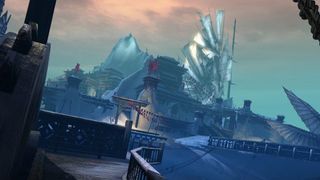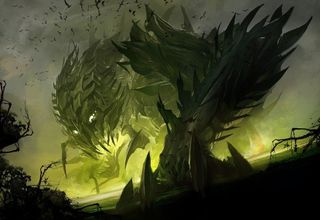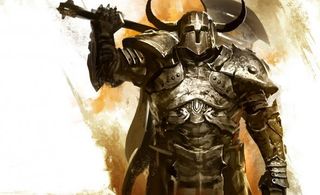Guild Wars 2: the kitchen sink post
Levelus maximus

"So, essentially when you get to max level, every event in the game is open to you as potential content for you to play through" Flannum says--even low level dungeons you might not have visited since the start of the game. All dungeon levels are fixed, so whenever you enter a dungeon of a level lower than your own, you will automatically scale down with the appropriate stats and weapon strengths. Even so, high level characters descending into low level dungeons will benefit from being slightly stronger than a first time entrant into the dungeon. For example, a max level character entering a level ten dungeon will be scaled down to the appropriate level including weapons, but the deleveling system will work in the player's favor enough to give them an edge over the content. Flannum told us that players higher level than a dungeon returning to it will be strong enough that good players "could definitely finish the dungeon with less than 5 players."
This will allow you to play with your friends that play the game, no matter how many levels apart your characters are. However, the gear won't change. Flannum also told us, "Rewards will be for the level of the dungeon. That being said, the armor and weapon sets that you can get as rewards for finishing a dungeon are completely unique in appearance so a player of any level might be interested in the dungeon rewards."
A never ending story

If you read the previous two posts (you have been reading them, right?) you're familiar with Story and Explorable Modes, but there are a few things that we learned about them that didn't quite make it into those posts. For starters, Flannum told us that, "The Story Mode is designed to be easier than the Explorable Mode. Explorable is also, as it's name implies... very replayable. One of the things we ran into doing missions, which is very much like this in Guild Wars 1, is that we found that doing a mission multiple times, a lot of story oriented stuff started getting in the way of you having fun. You started, 'Ok, I've seen this cutscene before, skip it.' Pretty soon this culture of skip the cutscene kinda grew up around Guild Wars 1, and so what we wanted to do was to provide people in that first story mode a linear, lots of cutscenes, lots of story going on, lots of exposition, that experience.
"...for the explorable mode it can be a lot more free-form, where you can just jump in and you're dealing with something that doesn't need as much explanation, doesn't have a lot of exposition, doesn't have a lot of cutscenes, and it has a lot of replayability built into it because there are different ways to complete it, or different paths to take. We tried to really vary each of them quite a bit so we actually don't fall into a pattern where it's like 'Well, Explorable is like there's three different paths you can take.' That is true sometimes, but sometimes there's three different ways, or sometimes it's multiple ways, not even three, maybe four ways. Sometimes it branches in the middle, sometimes it branches right at the beginning."
Although Explorable Mode is designed to be replayable and Story Mode is a more linear experience, both can be replayed as many times as you like. "They are not directly contingent upon each other, so whatever you've done in your personal story will not change what happens in the dungeons, or vice versa. But you will get to meet, depending on the branches you pick along your personal story, you may end up meeting some of the same characters, and experience different parts of the same storyline" says Flannum.
While dungeon running is sure to be a big draw, Flannum says the events there "don't tend to spill out into the outside world, and we do that because you're never sure whether or not, again we don't want to force players to do dungeons if they like to do events in the outside world, that sort of thing. Things inside of the dungeons can change quite a bit depending on what you've done, but it doesn't have a direct effect on the outside. The big difference in the dungeons is that...dungeon difficulty is a constant, so it's sorta geared for the players who really want a challenge, who really want to work out 'Hey, this is really a good group build. Let's see if it works in here,' and are looking for that experience of overcoming difficult content through teamwork. And it sort of pushes things to another level where it requires more coordination, where it requires you to work together a little bit better. It's a more challenging experience, it's the same fundamental gameplay, but it emphasises coordination and teamwork even more than other parts of the game."
Who's the boss?

Unfortunately, Tony Danza is not actually a boss in GW2, but there's always hope for the expansion, right Mr. Flannum? "[No.]" Though GW2 is lacking in the Danza department, veteran players are bound to recognize some of the bosses in the previously described Ascalon Catacombs. Flannum told us that, "In similar ways in the rest of the game, there are a lot of places players will get to go back and see [from the original game]. We showed some of those off at Colgone--Serenty Temple, Temple of the Ages; we're going to go back to the Ruins of Denvary. It's the sort of thing where we saw a really cool opportunity to provide some fan service to players, and show them some of the places they visited [in GW1]... We also wanted to make sure those things were cool for people who were not familiar with the original material as well. Many of the dungeons are locations that were never included in [GW1], and even includes races that are new to the game that players don't know about yet."
The biggest gaming news, reviews and hardware deals
Keep up to date with the most important stories and the best deals, as picked by the PC Gamer team.
Flannum also mentions an anti-griefing precaution they've taken. Although an elementalist can lay down a wall of fire to ignite his allies' arrows, that wall will not ignite incoming enemy arrows. Griefers will have to be a bit more creative than that if they want to exploit these developers' code.
All about the bling

Just as in GW1, loot plays an important part not only in stat modification, but character development. In GW2, that tradition is being expanded by the differences in drops between the Story and Explorable Modes. In Story Mode, you'll receive weapons that are comparable to those on the surface, but have a look unique to the dungeon in which they were found. Flannum provides the following example: "Sorrow's Embrace has a piece that looks very Dredge-like. If players wanted armor that looked like that, or weapons that looked like that, then they would need to go through there, but it's not as if the weapons are vastly more powerful than what you could find [elsewhere]." In Explorable Mode, players will be granted either light, medium, or heavy armor.
As far as the mechanics of the drop system is concerned, Flannum says "It's more of a badge system, so this is something that we did in Guild Wars 1 as well. Our basic philosophy is that you should never complete a piece of content and get something you don't want. So it's going to be the case where you go through and are guaranteed to get a piece of gear that you didn't have before, and that you're going to want." So, you're guaranteed to get a piece of gear every time you do a dungeon? "Yes." Sweet.
More specifically, we were told that weapons will come from story mode (one run = one weapon) and the rest of your armor will be earned from explorable mode.
Most Popular





